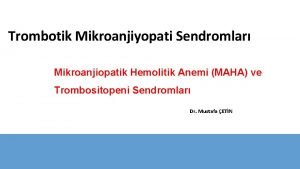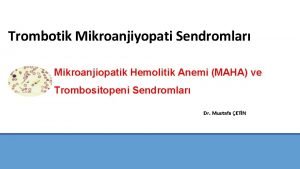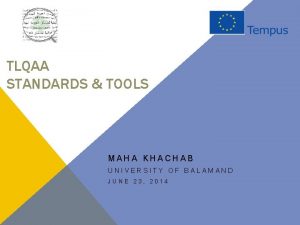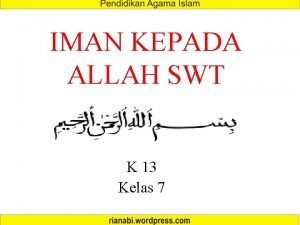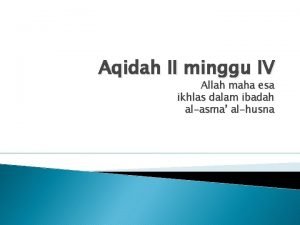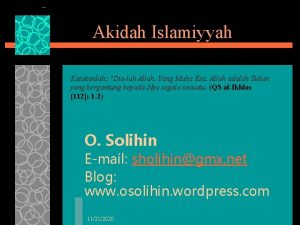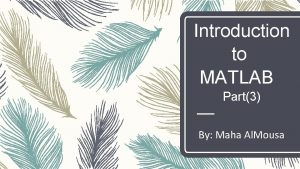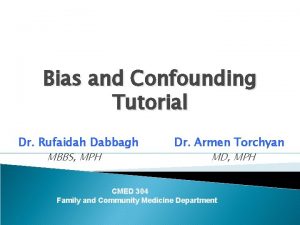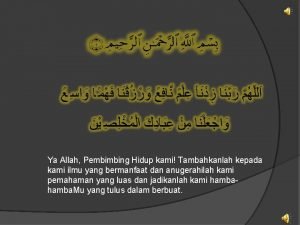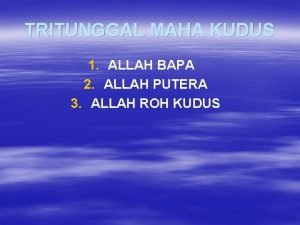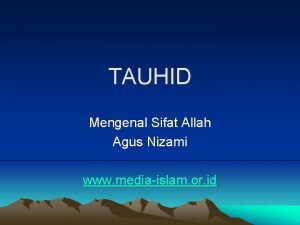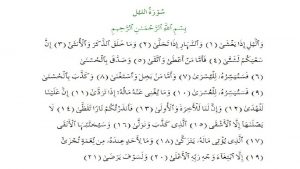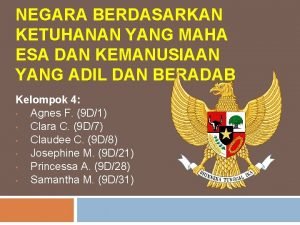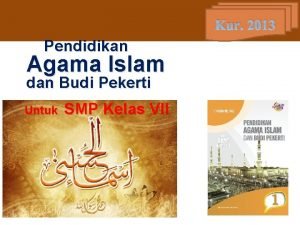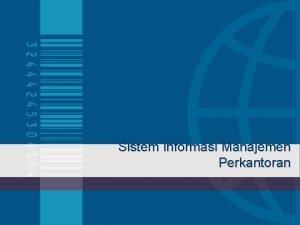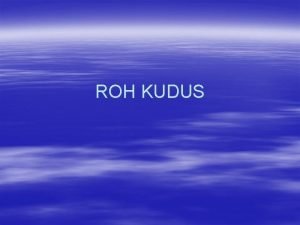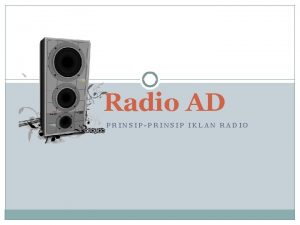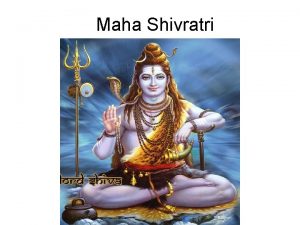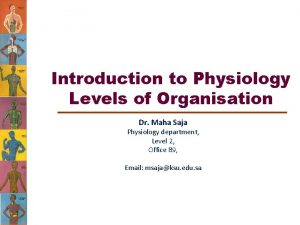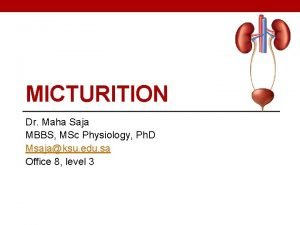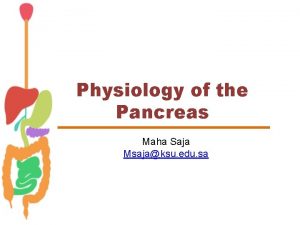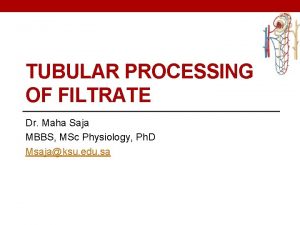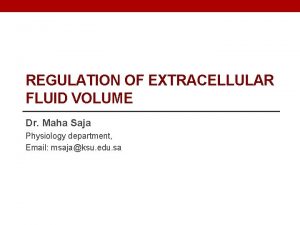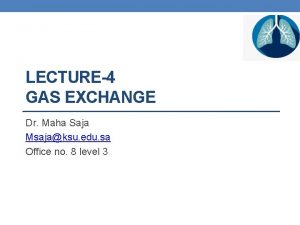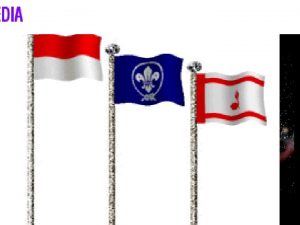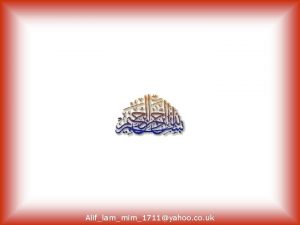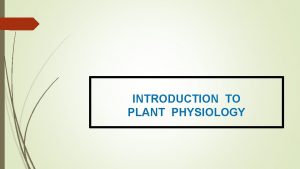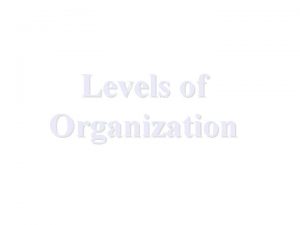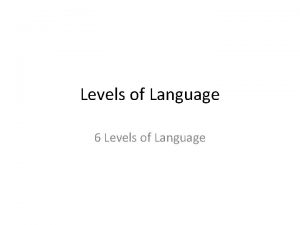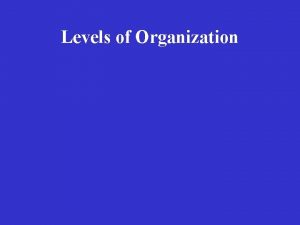Introduction to Physiology Levels of Organisation Maha Saja








































- Slides: 40

Introduction to Physiology Levels of Organisation Maha Saja

Objectives • Define physiology. • Describe the levels of organisation of an organism. • Discuss the internal environment and its importance in physiology.

What is Physiology? • = Physio- + -logy Ø Physio-: nature Ø -logy: science or study of • Physiology = The science dealing with the way a normal organism and their body parts function. • It is a cornerstone to medicine. What is the difference between anatomy and physiology of the heart?

Levels of Organisation The basic living unit of the body

Levels of Organisation Organism Anatomy & Physiology Organ system Histology Tissue Organ Cell Organelle Biochemistry/ chemistry Chemistry molecule Atom

The Cell The cell is the basic living unit of the body • Cells may differ markedly from one another, but they all share certain basic characteristics.


The Internal Environment “Milieu Intérieur” • All the cells in the body are continuously bathing in fluid. • Because this fluid is outside the cell, it is called extracellular fluid (ECF). • It is from the ECF that cells get the ions and nutrients needed to maintain life. • All cells in the body live in the same environment i. e. ECF (Guyton and Hall Textbook of Medical Physiology. 13 th ed. Ch-1)

“Milieu Intérieur” 1. All body cells live in the same environment i. e. ECF. 2. The composition of ECF is almost similar between the different species. → it was called the internal environment (milieu interieur) by the French physiologist Claude Bernard. ste wa rie n nut • From the ECF cells receive ions, nutrients and oxygen needed to maintain life. ts All cells of the body are constantly bathing in fluid. Because this fluid is outside the cells it is called “extracellular fluid (ECF)” (Guyton and Hall Textbook of Medical Physiology. 13 th ed. Ch-1)

Body Fluids

Objectives • State the water content of the body. • Describe the physiologic factors that determine the body’s water content. • Discuss water balance in the body with regards to intake and output. • Describe the physiologic mechanisms involved in water balance (the role of ADH hormone and thirst mechanism). • Enumerate the different body fluid compartments and state their normal volume. • Describe the composition of the different body fluid compartments. • Define osmolarity and state the normal osmolarity of body fluids. • Explain the effects of placing a cell in solutions with varying tonicity on the cell volume. • Enumerate fluids used in clinical practice and state their tonicity compared to that of normal body fluids. • Describe the effects of infusing IV fluids with different tonicities on the volume of the different body compartments. • Define edema and describe its various kinds.

Body Fluid Content • Total body fluids ≈ 60% (50 -70%) of total body weight (TBW). • Body fluids = water + dissolved solutes. § Solutes 60% Water Electrolytes (Na+, K+, Cl-, HCO 3, Mg+2, Ca+2) Non-electrolytes (glucose, urea, creatinine) • Total body water ≈ 60% of TBW. (Guyton and Hall Textbook of Medical Physiology. 13 th ed. Ch-25)

Calculate the total body water content of a 30 -year-old 70 kg man?

Physiologic factors affecting body water content • Is body fluid/water content similar between; Ø Child & adult? Ø Young & old? Ø Male & female?

Continue. . Physiologic Factors Affecting Body Fluid Content

Water Balance • Cells are largely made of water and are surrounded by a “sea” of water. • Water is constantly being exchanged between the cells and surrounding environment. • Keeping a constant volume of water is essential for homeostasis.

Maintenance of Fluid Balance Input = output Water intake: • Fluids ingested (2100 ml). • From metabolism (200 ml) Total intake = 2300 ml Daily loss: • Insensible loss (700 ml). • Sweat (100 ml). • Feces (100 ml). • Urine (1400 ml). Total loss = 2300 ml

Disturbances in Fluid Balance Water/fluid intake • Intake is variable • Depends on: – Climate – Habits – Physical activity. Water/fluid output • • Burns Exercise Hot weather. Diarrhea Vomiting Blood loss Diabetes

Regulation of Fluid Balance Modify intake → thirst Modify output→ Kidney excretion Major ouput Major input

Regulation of Fluid Balance Water deficit • Input < output. • Leads to: – Hypovolemia – Dehydration • Physiologic regulation: 1. Activates hypothalamic thirst centre → ↑fluid intake • The hypothalamic thirst centre is activated by: – ↓ ECF volume (10 -15%) – ↑ ECF osmolarity (1 -2%) 2. ↑ ADH secretion by posterior pituitary → ↑ water reabsorption by the kidney. Water excess • Input > output • Leads to: – Hypervolemia. – Edema. • Physiologic regulation: 1. ↓ ADH secretion → ↓ water reabsorption → ↑ water excretion by kidney. 2. Decrease thirst


Oedema • What is “edema”? – Edema = swelling – The presence of abnormally large amounts of fluid in the intercellular tissue spaces of the body. • What causes edema?

Types of Oedema Intracellular Extracellular • Due to intracellular swelling. • More common clinically • Caused by: • Hyponatremia. • Depressed metabolism • Lack of nutrition to the cells. • Inflammation. • Due to accumulation of fluid in the extracellular space Can be seen in: • Heart failure • Kidney disease

How is this water/fluid distributed in the body? Where is this 60% of fluid/water located in the body? Plasma

Body Fluid Compartments Total body water = 60% TBW *2/3 (40% of TBW) Intracellular Transcellular fluid (specialised type of ECF e. g. synovial, CSF, ocular, pericardial, pleural, peritoneal fluids)= 1 -2 L 1/3 (20% of TBW) Extracellular ¾ (15%) Interstitial Fluid ¼ (5%) Plasma N. B. the fractions refer to its relation with the preceding compartment. While the percentage refers to its relation to TBW) (Guyton and Hall Textbook of Medical Physiology. 13 th ed. Ch-25)

Let’s go back to our 30 -year-old man Calculate the total body water content of a 40 -year-old 70 kg man? • TBW = 42 litres • How many litres lie intracellularly? Ø 42 X ⅔ = 28 L OR 70 X 40/100 = 28 L. • How many litres lie extracellularly? Ø 42 X ⅓ = 14 L OR 70 X 20/100 = 14 L. • How many litres constitute the interstitial fluid? • How many litres are plasma?

Does the composition of the different differ?

Constituents of the Different Body Fluid Compartments Intracellular compartment Extracellular compartment ↑↑ Na+ ↑↑ Cl-, HCO 3↓↓ K+ Cell membrane Interstitial fluid Capillary wall Proteins Plasma ↑↑ K+ ↑↑ Phosphate (PO 4 -3) ↑ Proteins ↓↓Na+ ↓↓ Cl- Cations = anions ECFs are constantly mixing and Cations = anions have the same composition except for proteins. Osmolarity is the same ≈300 m. Osm/L

What is Osmolarity? • A unit of concentration. • It measures how concentrated or diluted a solution is. • Defined as = the number of osmoles of a solute per litre of solution. • The normal osmolarity of body fluids is ≈ 300 m. Osm/L

What is Tonicity? • Osmolarity describes the concentration of one solution. • Tonicity is used to compare between the osmolarities of two or more solutions separated by a semi-permeable membrane. Which solution is hypertonic to B? 100 mosm/L A 200 mosm/L B 400 mosm/L C

Why is it important? The difference in tonicity between two different solutions separated by a semi-permeable membrane determines the movement of water.

Osmosis • It is the movement of water across a semipermeable membrane from a region of low solute concentration to a region of high solute concentration.

How does it apply to physiology? The cell membrane is a semi-permeable membrane (Allows only water to move freely across it)

How is it related to patient care? 1. Physicians administer fluids to patients for various reasons that may change the osmolarity of ECF. 2. Abnormalities in electrolytes can change the osmolarity of ECF and can affect the cells a. Hypernatremia (↑ Na conc. In ECF) b. Hyponatremia (↓ Na conc. In ECF) • There are many types of IV fluids with different tonicities.

Types of IV Fluids Hypotonic Isotonic 0. 9% Saline (Na. Cl in water) 0. 45% Saline Dextrose (5% glucose) Hypertonic Dextrose in 0. 9% saline

What happens to the different compartments with the administration of IV fluids?

What happens to the different compartments with the administration of IV fluids? Adding hypertonic solution • ↑ ECF osmolarity • Water moves out of cells into ECF. • ICF volume decreases. • ECF volume increases. • ↑ ICF osmolarity Adding isotonic solution • No change in ECF osmolarity. • No osmosis occurs through cell membrane. • ECF volume increases. Adding hypotonic solution ? Activity

Water distribution in the body An exercise • After learning about water content of the human body, a 60 kg medical student was curious to calculate her own body water content. What would you expect the total volume of her body water to be? • And what is the volume of the following compartments? – – ICF ECF IF Plasma

In summary

Thank you
 Costas level of questions
Costas level of questions Waistline
Waistline Anterior posterior distal proximal
Anterior posterior distal proximal Chapter 1 an introduction to anatomy and physiology
Chapter 1 an introduction to anatomy and physiology Introduction of forms of business organisation
Introduction of forms of business organisation Introduction of business organisation
Introduction of business organisation Introduction of business organisation
Introduction of business organisation Mikroanjiyopati
Mikroanjiyopati Ttp pentad
Ttp pentad Maha khachab
Maha khachab Suci suci suci tuhan maha kuasa
Suci suci suci tuhan maha kuasa Maha ravana
Maha ravana Takwa kepada tuhan yang maha esa
Takwa kepada tuhan yang maha esa Allah memiliki sifat al matin artinya allah maha
Allah memiliki sifat al matin artinya allah maha Maha district 6
Maha district 6 Al bashir artinya allah maha
Al bashir artinya allah maha Maha shouman
Maha shouman Allah maha esa
Allah maha esa Katakanlah dialah allah
Katakanlah dialah allah Voltērs
Voltērs Maha diagnosis
Maha diagnosis Maha el keshawi
Maha el keshawi Maha ka matlab
Maha ka matlab Dr maha dabbagh
Dr maha dabbagh Allah maha pembimbing
Allah maha pembimbing Allah tritunggal maha kudus
Allah tritunggal maha kudus Allah maha mengetahui
Allah maha mengetahui Surah allail
Surah allail Srinivasa ramanuja
Srinivasa ramanuja Shivani kulkarni
Shivani kulkarni Iman dalam bahasa arab
Iman dalam bahasa arab Negara berdasarkan ketuhanan yang maha esa
Negara berdasarkan ketuhanan yang maha esa Peta konsep asmaul husna kelas 7
Peta konsep asmaul husna kelas 7 Dengan nama allah yang maha pemurah
Dengan nama allah yang maha pemurah Bentuk solid
Bentuk solid Fungsi dari pemeliharaan dokumen adalah
Fungsi dari pemeliharaan dokumen adalah Sistem informasi perkantoran
Sistem informasi perkantoran Nama keturunan prabu siliwangi
Nama keturunan prabu siliwangi Simbol-simbol roh kudus
Simbol-simbol roh kudus Apa saja karakteristik iklan radio
Apa saja karakteristik iklan radio Hal yang tidak diperhatikan dalam menulis puisi adalah
Hal yang tidak diperhatikan dalam menulis puisi adalah







